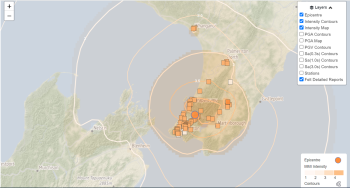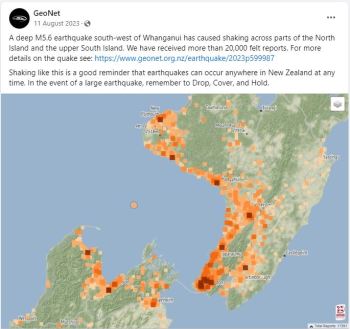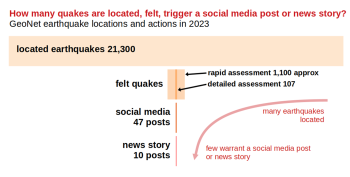
Earthquakes and Response Actions – Digging into the Numbers
Welcome, haere mai to another GeoNet Data Blog. Today’s blog is about numbers of earthquakes versus felt earthquakes, and when we publish social media and new stories about earthquakes.
Most of you know that Aotearoa New Zealand has lots of earthquakes. Each year we locate 20,000, plus or minus a few thousand depending on the level of activity. But what about other things. How many earthquakes are reported felt, and how many prompt us to take further action, specifically issuing a post to social media or a new story to our app or website?
Earthquakes – located and felt
Our 2023 review highlighted that our automatic systems and National Geohazards Monitoring Centre (NGMC) located 21,300 earthquakes in 2023. These ranged from the very small that were only recorded by our sensitive instruments, through to larger events felt over a wide area of the country.
We have two ways for you to tell us you’ve felt a shake. The most commonly used is Felt RAPID available through our app (Android and iOS) and website. We also have more detailed felt reports available through our website known as Felt Detailed.
Most people use Felt RAPID because you simply chose one of six images, and descriptions, that most closely represents how you felt an earthquake. Felt RAPID is fully automatic and as its name suggests, is used for collecting felt information soon after an event. For these reasons, it can’t be very rigorous in assigning a felt report to a specific earthquake. Felt RAPID does this assignment by simply comparing the time of your report with the time of earthquakes we’ve located. We can’t be completely sure how many earthquakes have Felt RAPID felt reports associated with them.
Felt Detailed collects much more detailed information and mostly gets reports for larger events. The felt reports are carefully reviewed by GNS Science experts. Because Felt Detailed typically works with reports a little after an earthquake has occurred, and because it has a rigorous checking process, reports can usually be confidently associated with earthquakes we’ve located. We know accurately how many located earthquakes have Felt Detailed felt reports.
So, how many earthquakes are felt in Aotearoa New Zealand each year? Our felt report experts tell us that the number of earthquakes reported felt through Felt RAPID is approximately ten times the number reported felt through Felt Detailed. We know that in 2023 Felt Detailed has reports from 107 earthquakes, so, in the same period, we estimate that Felt RAPID registered reports for approximately 1,100 earthquakes. These are our best estimates of earthquakes reported felt in 2023.
If you are reading carefully, you’ll have noticed that we keep saying “reported felt”. We are trying to make a clear distinction between how many people may have felt an earthquake and how many used Felt RAPID or Felt Detailed to report they felt it. Of course, there’s no compulsion to tell us you felt an earthquake, though we appreciate it when you do. We can never know how many people actually felt an earthquake.
Further actions for felt earthquakes
When an earthquake occurs that is reported felt by at least 2,000 people through Felt RAPID, our NGMC takes further action. They notify our Seismic Duty Officer (SDO) and Communications Duty Officer (CDO). Together, they assess the earthquake and decide what action is required, depending on where it occurred, the magnitude, how many people reported feeling it and where.
Part of the assessment process uses reported felt data to obtain macroseismic intensities that measure the level of shaking at each location. These data are used in our new Shaking Layers tool (available on our website or app) to make an easily understood map. Data points are an average value of the reports in each suburb/town, provided there are at least three reports. Currently, only Felt Detailed felt reports are used in Shaking Layers, but research is being developed to look at using Felt RAPID reports too.
In pretty much every case if at least 2,000 people complete reports through Felt RAPID, our CDO and SDO prepare information to send out via social media. Our social media posts go out on X (formerly Twitter) and Facebook. The idea is to inform and reassure people ahead of any actions by other agencies. In 2023, our Communications team put out 47 social media posts about earthquakes.
There are sometimes cases where our Communications team decides to follow up with more detailed information than was put in a social media post. This is where we write a news story that goes on our app and website.
News stories provide an opportunity to add context, provide an update on felt reports, and potentially talk about aftershocks and aftershock forecasts. If an earthquake occurs during the night, a news story will typically be produced the next morning, otherwise a few hours after an earthquake. We will sometimes update a news story if new information comes to hand.
Most earthquake news stories are about a single earthquake and potentially it’s aftershocks, but we did one in 2023 about a severe swarm of earthquakes that affected the Kawerau area in the Bay of Plenty. That swarm was quite interesting from a data perspective and earned its own blog post.
In 2023, our Communications team published ten news stories in response to earthquakes (or an earthquake swarm).
Putting it all together
There is a big range between 21,300 located earthquakes and ten news stories. To illustrate the progression from located through felt and social media to news story, we made something called a funnel chart. Its name comes from the shape of a funnel used for pouring a liquid into a container. Funnels charts are most commonly used in business situations, but it works quite well in this case.
You read a funnel chart by starting at the top and working your way down. The width of each bar corresponds to the number of cases, and you can see how the number in each category gets less and less. In the case of earthquakes and how many are reported felt, or require a social media post or news story, the funnel chart clearly shows how quickly the number drops with each step.
About 5% of the total earthquakes located by GeoNet in 2023 were reported felt. About 0.2% of the total warranted a social media post, that is about 5% of the number reported felt.
That’s it for now
So, there you have it, a lot of smaller earthquakes and (fortunately) only a few large enough to be felt, and only a few of those needing a social media post or news story. The next time you grab a funnel to put fuel into your motor mower or liquid into a jar, think about all our earthquakes and the numbers involved in each of the stages.
You can find our earlier blog posts through the News section on our web page just select the Data Blog filter before hitting the Search button. We welcome your feedback on our data blogs and if there are any GeoNet data topics you’d like us to talk about please let us know!
Ngā mihi nui.
Contact: info@geonet.org.nz





